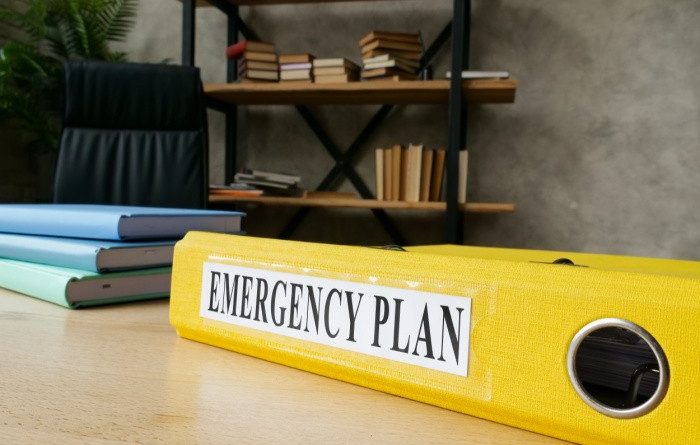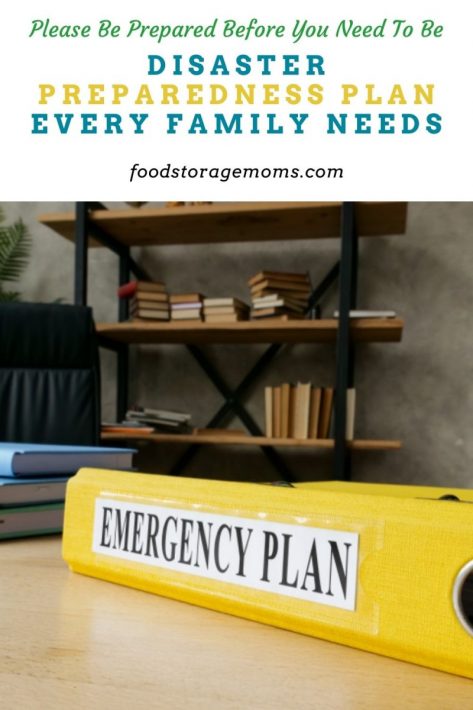
By Linda Loosli
No matter how careful we are to avoid accidents, live and eat following a healthy regimen, study about and react to possible pending weather or changing climate challenges, and many other critical issues, things happen to all of us that may have taken us by surprise. Many things that come our way are out of our hands, but we do have a choice about preparing for most disasters.
Disaster Preparedness Plan Every Family Needs

We’ve all heard about the importance of storing food and water and learning how to prepare meals from our stash, but there is so much more that goes into truly feeling prepared for most contingencies that come our way.
Below, I’ve tried to summarize the plans you need to make for the overall safety and survival of your family, no matter what the cause or circumstances. Besides my own personal experiences, I’ve researched other great sources of information to help put this post together. Some are from government sources, along with prepper websites and posts of related topics from those I trust.
Although disasters and other emergencies can come in a wide range of situations and circumstances, there are some general guidelines we all can follow as we develop a comprehensive plan of preparation. These can come in the form of simple steps that may be easy to implement, but others can take considerable time, energy, and funds to accomplish.
The outline below isn’t necessarily in a particular order or priority, but I do tend to spell out the need for food and water first in most of my preparedness summaries. It’s just me! I’ve always contended that the old adage, “If you fail to plan, you plan to fail” is certainly a truism.
When it comes to being prepared you need to be systematic in putting your thoughts to paper before you go out and spend a lot of money, organize haphazardly, and implement action steps that may not work as expected.
Let’s talk about the most common steps or action items you’ll need to consider as you put your plan together
Water Storage Is A Must
Water storage is the key component of a good disaster plan. We all need adequate water to survive. It is even more important than the food you store. Actually, food and water complement each other since you generally will need to reconstitute many of your foods with water so they can be eaten directly or added as ingredients in the family meal planning.
Some people have suggested we can get along with one gallon of water per person each day. My gut feeling has always been that four gallons is more realistic as we try to prepare for drinking, meal preparation, personal hygiene, and minimal laundry efforts.
You need to remember that water might not be available during the disaster, so plan ahead. Check out my posts regarding water storage issues, it’s a good read for anyone serious about the proper steps for water storage and use.
We Can’t Survive Without Food
We seldom know when a disaster will strike, so having food in the pantry, and possibly elsewhere in your house, like a basement storage room, is a wise use of money and space. Yes, you can go for longer periods without food than you can with your water, but just think how you felt the last time you skipped a meal or two. You tend to get very hungry, have limited energy, and you might even get a little grumpy. Who wouldn’t?
Other Items We Need To Store
Don’t forget to plan on other critical items you’d expect to need in an emergency, like a first aid kit, toiletries, medications the family has to have, light-generating items like flashlights, batteries, lanterns, etc., infant and elderly needs, cooking support items and safety concerns like a fire extinguisher. Most of these are needed if you decide to stay put.
What If You Have To Evacuate?
Think about what you’ll need if you have to evacuate, either on your own or under the direction of local authorities. This isn’t a decision you make off the cuff, there needs to be considerable thought put into this. Things like what do we take, where will we go, how do we get there, will roads be open and accessible for the entire route, and what will we have when we get there?
What About Those Important Documents?
Don’t just think about clothing and those types of items. You need to consider that your home could be destroyed while you’re gone. What about those very important papers like birth and marriage certificates, home and car titles, insurance and health information, tax files, old photos, and so much more.
Check out my printable critical documents binder, it can provide some get organizational ideas that can help you.
Is Your Vehicle Ready If You Have To Evacuate?
There is also the need to plan ahead for the vehicle you’ll use if you decide to evacuate. Is the tank reasonably full, is it properly serviced if you have to travel a fair distance, do you have an emergency kit inside that has been checked lately for current and usable supplies, etc. Be sure to have some extra blankets to keep you warm and a complete first aid kit, just like at home.
Is Your Home A Safe Place To Stay?
If the decision is to stay at home, there are plans for that choice too. If you stay, make sure you have a safe haven and not one that is hazardous. Do you have a fire extinguisher, tools, facilities to cook, etc. I’ve harped for years that alternative cooking options are a must?
I have butane stoves, propane for my BBQ, a Sun Oven so I can cook outside if needed, and even fuel for a fire pit cooking experience. I recently wrote a post about that
How Will We Communicate?
The need to communicate is also vital. You need a detailed plan for the use of cell phones, radio and/or TV access, ham radio or walkie-talkies, and other communication options. I have a crank radio I love. It will work even if the power is off and it includes weather channels so I can keep up to date regarding what’s going on outside and around my area. If you don’t have current information, how can you effectively react?
Where Is A Good Place For The Family To Meet?
Keep in mind that disasters seldom happen when everyone is at home. As part of your plan, you need to consider on any given day, where will we be and how can we stay in contact and eventually meet at a pre-determined location? You should consider more than one location in case the disaster is somewhat centralized and causes travel and unique safety concerns.
Are Your Kid’s School And Your Workplace Properly Prepared
As mentioned above, disasters can happen at any time of day, often when the family is away doing things that families do. You can plan all you want for at-home emergencies, but what if the kids are at school and you and your spouse are at work? You should immediately check to see if there are preparedness plans in place at both locations, and if not, offer to help put one together.
Some schools, particularly private ones, may not have thought about the risks involved at the school if a disaster happens during school hours. Businesses are similar, especially if the business is located in a large campus or building complex. Each location should have a plan that covers a “what do we do if” scenario. Schools lose roofs and windows in violent storms. They also have fires that can spread quickly from classroom to classroom. At a minimum they need evacuation plans, but what if it’s not safe to evacuate.
Businesses are also subject to earthquakes and other emergencies where staff members are put at risk. There should be evacuation plans there too, along with discussions about elevator safety issues and if staff need to take the stairs, etc.
Be Sure To Test Your Plan
Plan your work, then work your plan. You can’t assume just because you have a plan that it will be foolproof. Get your plan put together and then test it out. Go through the various issues we’ve discussed and see if you’ve covered everything. Have some exercises where you stay in place and also when you evacuate. Test your communication system, try the meeting place exercise, have the school try out their emergency plans under different disaster scenarios.
Have You Covered Every Issue In Your Plan?
As you and your family go through the exercises ask yourself the following questions:
How will I receive emergency alerts and warnings?
What is my family communication plan?
What is my shelter plan, and do we need to evacuate?
If we do need to leave the house, where will we go, how will we get there, are there alternates we need to consider, etc.?
Did I remember my 72 Hour Kit?
Is the car or truck gassed up, emergency kit in hand, and ready to go?
Sally is a dance, how can I get in touch with her to see if she’s ok, and how can I meet her now?
In case you missed this post, How to Barter with Food and Water
Final Word
Hey, this is just a short summary of the things we all need to consider when planning for a disaster. People smarter than me have written whole books on each section of this post. I’ve barely scratched the surface of the planning process. I promise, if you follow these guidelines, along with your own study of what needs to be considered, and then follow those directives, you’ll be able to sleep better knowing you did your best to protect your family by planning ahead. May God bless this world. Linda
No comments:
Post a Comment